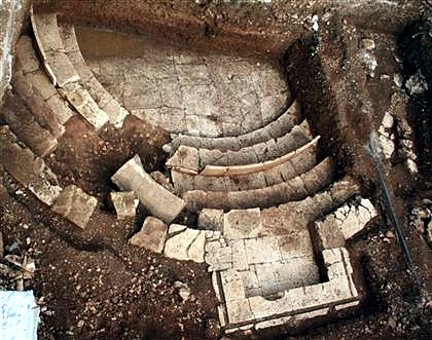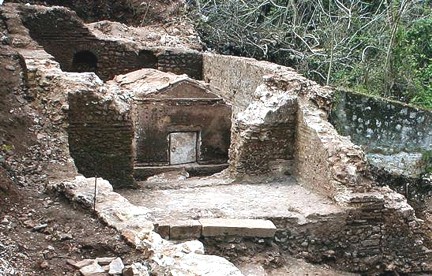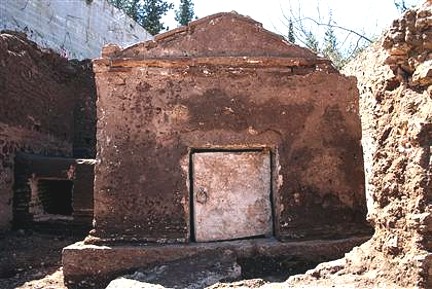Hallan cripta y teatro romanos en isla Cefalonia al oeste de Grecia
Foto: Rows of stone seating and a stone-flagged pavement from what archaeologists believe may have been an ancient theater are seen in this undated handout photo released by the Greek Culture Ministry on Wednesday, April 4, 2007. Digging on the western island of Kefallonia, archaeologists have also discovered a large Roman-era tomb with its ancient offerings intact. The complex, which contained five burials, yielded gold jewelry, glass and clay pots and bronze artifacts, a Culture Ministry announcement said. Associated Press.
La cripta, de dimensiones de 8.20 por 5.80 metros, tiene tres sepulcros y uno de ellos representa la fachada de una vivienda.
Las excavaciones en un predio de la isla de Cefalonia, en el oeste de Grecia, revelaron la presencia de una cripta con tres tumbas que no han sido profanadas y de un teatro, de la época romana, según informa hoy la prensa ateniense.
El descubrimiento durante la construcción de una vivienda y de una cisterna fue hecho en diciembre de 2005 en la localidad de Fiscardo, y los arqueólogos han trabajado desde entonces y han encontrado también cántaros de cristal y de cerámica, joyas de oro y objetos de bronce con relieves y monedas.
La cripta, de dimensiones de 8.20 metros por 5.80, tiene tres sepulcros y uno de ellos representa la fachada de una vivienda y los arqueólogos expresan su emoción por el hecho de que la puerta se abre y cierra con facilidad, como hace tres mil años.
Además, la cripta contiene otras dos tumbas de piedra.
En declaraciones recogidas por la prensa, Andreas Sotiriou, experto del servicio nacional de arqueología, afirmó que se ha descubierto por primera vez en el grupo de las islas Eftaniasa un odeón o un pequeño teatro casi intacto de 7.65 metros de largo y con cuatro líneas de butacas, además de un lugar para la orquesta de 5.45 metros de diámetro.
Los científicos incluyen los descubrimientos en el predio de Fiscardo con otros provenientes de tiempos romanos en las cercanías, como los vestigios de un patio rodeado de ruinas de viviendas y de un cementerio.
Fiscardo, actualmente un pueblecito pesquero y turístico en la parte norte de la isla, parece haber sido en la época un importante puerto entre la península griega y la italiana y mantenía estrechos lazos con la colonia romana de Nikopolis, en el noroeste de Grecia.
Fuente: EFE, Atenas, Grecia. 5 de abril de 2007
(2) Greek archaeologists unearth rich tomb
Roman-era building contains gold jewelry, pottery and bronze offerings.
ATHENS, Greece - Archaeologists on a Greek island have discovered a large Roman-era tomb containing gold jewelry, pottery and bronze offerings, officials said Wednesday. The building, near the village of Fiscardo on Kefalonia, contained five burials including a large vaulted grave and a stone coffin, a Culture Ministry announcement said.
The complex, measuring 26 by 20 feet, had been missed by grave-robbers, the announcement said.
A large Roman-era grave complex discovered on the western Greek island of Kefallonia is seen in this undated handout photo released by the Greek Culture Ministry on Wednesday, March 4, 2007. At center is seen a large, house-shaped grave with a stone door that still works perfectly. The complex, which contained five burials, yielded gold jewellery, glass and clay pots and bronze artefacts, a Culture Ministry announcement said. (AP Photo/Culture Ministry)
Archaeologists found gold earrings and rings, gold leaves that may have been attached to ceremonial clothing, as well as glass and clay pots, bronze artifacts decorated with masks, a bronze lock and copper coins.
The vaulted grave, a house-shaped structure, had a small stone door that still works perfectly turning on stone pivots.
On a nearby plot, archaeologists also located traces of what may have been a small theater with four rows of stone seats, the ministry said.
A handout photo released by Greek Culture Ministry on 04 April 2007 shows a well preserved Roman-era funerary chamber unearthed by archaeologists on a private property in Fiscardo, on the Ionian island of Cephalonia. The tomb, which had not been looted by any plunderers, contained several funerary objects, including a stone sarcophagus, glass and clay vessels, gold earings, rings and hair pins. ARIS MESSINIS / AFP/Getty Images
Previous excavations in the area have uncovered remains of houses, a baths complex and a cemetery, all dating to Roman times between 146 B.C. and 330 A.D.
Copyright 2007 The Associated Press.



0 comentarios